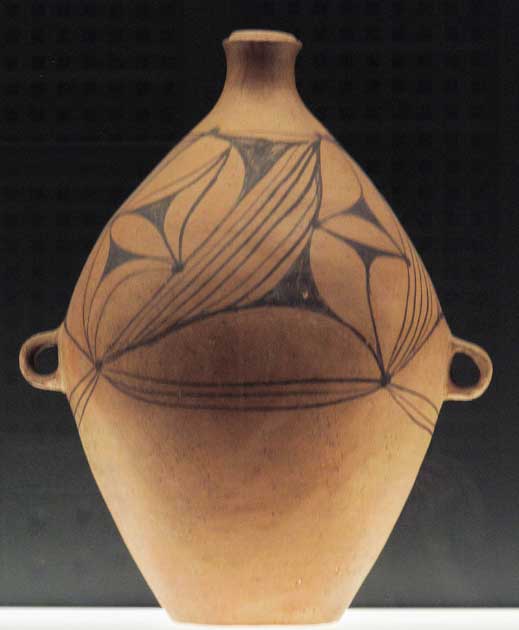5,200-Year-Old Carved Stone Chrysalis Unearthed from the Dawn of The Silk Road
Sericulture, or the rearing of silkworms to produce raw silk, was perfected by ancient China as early as the Yangshao period (5000-3000 BC), a thriving Neolithic culture. The marvels of silk and the technology would travel all across the overland Silk Routes during the 1st century AD, and onwards, earning admirers all over Asia and Europe. Now, archaeologists have discovered a 5,200-year-old crafted stone chrysalis in north China’s Shanxi province as of last month, showing just how long the silk industry has been important to China’s ancient cultures.
The Find and the Neolithic Yangshao Culture
According to the Chinese state news agency, Xinhua, the Provincial Archaeology Research Institute (PARI), which declared the find, reported that the stone chrysalis is just 2.8 cm (1.1 inches) long, with the largest portion of the abdominal diameter measuring 1.2 cm (0.47 inches). It was found in a semi-crypt house at the Shangguo Site in Wenxi County in the city of Yucheng. It was dated, incidentally, to the early stages of the late Yangshao Culture era, some 5,200 years ago, based on pottery fragments.
"At present, many silkworm cocoons and chrysalises discovered in Yuncheng City have been found in good condition, indicating that the ancestors of Yangshao Culture in southern Shanxi had raised silkworms," said Tian Jianwen, a researcher with the PARI.
Very crucially, the discovery of stone carved chrysalises provided important clues for the study of the origin and spread of silk, according to Tian. He added that over the past century, scattered relics related to the silkworm culture have been found all over Yuncheng City.
- Surprising 5,000-Year-Old Cannabis Trade: Eurasian Steppe Nomads Were Earliest Pot Dealers
- Discovery of Ancient Chinese City Rewrites History
Pottery’s Role in Civilizational Progress and Yangshao
In fact, the Yangshao culture is renowned for its pottery, found all over its expanse which stretched along the middle of the Yellow River. What is particularly significant is the red-painted pottery from this culture and the spiral red earthenware pots, which were made in ovens at soaring temperatures of 1000°C-1500°C, reports Arkeo News.
The latter flourished before 2000 BC, while the former came after and was associated in general with the Neolithic period in China. The PARI investigation revealed that the artisans of Yangshao were highly sophisticated, an indication of how far the civilization had developed. Fine white, red, and black painted pottery was created, with intricate designs – human faces, animals, geometric shapes, all without pottery wheels.
The study of pottery is an invaluable insight into past cultures, with archaeologists analyzing the ‘fabric of pottery’ using fabric analysis. Fabric analysis helps understand the archaeological culture of the site – usage, source material, decorative patterns, amongst others. The characteristics and level of work help us understand the sophistication or advancement of a particular civilization, providing a window into the lifestyle, trading habits, technology, tools, to name a few.
- The Jewels of the East: Top 8 Ancient Capitals of China
- Erlitou: China’s First Great City and Beginning of the Xia Dynasty?

Large water vessel of the late Yangshao culture or early Majiayao; from Shaanxi, Shanxi or Gansu province; 4th millennium BC; Rietberg Museum (Zürich, Switzerland) (CC BY-SA 4.0)
Pottery is also a valuable aid during archaeological excavations for its high survival ability and durability. Fragments survive much longer than other contemporaneous materials, helping to corroborate written sources of the time too.
Archaeologists develop an understanding of societal organization and cultural development, which allow deductions to be drawn about daily life and religion as well. For example, from Jiahua, another Neolithic site on the Yellow River from the Peiligang culture, other such evidence was found back in 2017 from a whopping 8,500 years ago! This points to how early the development of cultures in the Chinese mainland had occurred – there were very few civilizations that could boast of such high sophistication at the time.
From the current stone carving chrysalis, the PARI team deduced that the Shangguo site had two main periods, mainly the middle and late Yangshao period. There was also the late Western Zhou period (1045 BC to 771 BC) which extended up to the Spring and Autumn period (770 BC to 476 BC). Various relics outside of pottery ware have been found to add to the finds over a 500 square meter radius. These include stove sites, jade ware, bone and stone tools, copperware, ironware, shellfish and a fruit stone – almost 1600 pieces in total!
Top image: The stone carved chrysalis found at the Shangguo Site in Wenxi County in the city of Yuncheng, north China's Shanxi Province. Source: Provincial archaeology institute of Shanxi/Handout via Xinhua
By Sahir Pandey
References
Büyükyıldırım, O. 2022. 5,200-year-old stone carving silkworm chrysalis discovered in north China. Available at: https://arkeonews.net/5200-year-old-stone-carving-silkworm-chrysalis-discovered-in-north-china/.
Xinhua. 2022. 5,200-year-old stone carving chrysalis found in north China. Available at: http://www.chinaview.cn/20220718/9ff4915a83394d1089cea9e76c3f5517/c.html.




















Comments
"It was dated, incidentally, to the early stages of the late Yangshao Culture era, some 5,200 years ago, based on pottery fragments."
How was it determined that the object was created when the pottery was? It could have been a prehistoric relic already at that time, especially if there was only one.
Nobody gets paid to tell the truth.